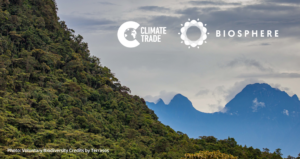
The International Union for Conservation of Nature (IUCN) Red List highlights the urgency of protecting the identified hotspots. While the focus has traditionally been on climate change metrics like CO2 equivalent, setting biodiversity conservation targets remains a challenge due to the lack of a universally accepted measurement standard.
The transport industry and the voluntary carbon market
The Voluntary Carbon Market (VCM) presents a unique opportunity for transport companies to actively address the biodiversity crisis while pursuing their net-zero strategies. Recognizing the significant challenges faced by the transport sector as a vital yet hard-to-abate industry, the VCM allows these companies to go beyond conventional carbon offsetting by incorporating biodiversity credits into their sustainability initiatives. By participating in the VCM, transport companies can invest in projects that not only reduce carbon emissions but also contribute to biodiversity conservation and ecosystem restoration. Purchasing biodiversity credits enables these companies to support initiatives such as reforestation, habitat preservation, and sustainable land-use practices.
How can the transport industry integrate biodiversity credits as part of their net-zero strategy?
The transportation sector can strategically incorporate biodiversity credits into its net-zero strategy through various use cases, providing a comprehensive approach to conservation and sustainability. The following use cases come from the World Economic Forum’s Biodiversity Report, December 2023.
1 – In the first use case, companies in the transportation sector may purchase biodiversity credits alongside nature-based solutions (NbS) to enhance carbon credits. This approach ensures that carbon and biodiversity outcomes are coordinated, mitigating the risk of carbon credits negatively impacting nature. By issuing carbon credits with a biodiversity “premium” or separately, projects can explicitly price biodiversity improvements, promoting ecological health and contributing to nature-related targets.
2 – In the second use case, companies can use biodiversity credits to finance improvements in natural capital within their value chain, securing access to vital ecosystem services. For instance, a transportation company relying on local water supply could invest in biodiversity credits to support the health of ecosystems providing this resource. The credits add a layer of verification and third-party assurance, enhancing the company’s nature risk management.
3 – The third use case involves companies contributing to global nature goals by purchasing biodiversity credits to protect and restore nature beyond their direct impacts. For example, a car manufacturer might invest in credits for the restoration of a globally threatened habitat, aligning with global biodiversity goals and enhancing the company’s business value.
4 – In the fourth use case, companies can offer products and services bundled with biodiversity credits, allowing consumers to support positive nature outcomes through their purchases. This approach aligns with consumer preferences and willingness-to-pay, providing a tangible and verifiable connection between the product and nature improvement.
While these use cases present opportunities for the transportation sector to integrate biodiversity credits into their net-zero strategy, it’s essential to acknowledge the contested nature of the fifth use case. This involves taking responsibility for unmitigated biodiversity impacts, and its applicability is subject to ongoing debate and requires additional market infrastructure development. Transportation companies should carefully consider these use cases, assess their specific circumstances, and leverage biodiversity credits alongside other instruments to support their net-zero goals.
Read our feature in Mongabay – ‘Biodiversity credits market must learn from carbon offset mistakes’
- SEO Powered Content & PR Distribution. Get Amplified Today.
- PlatoData.Network Vertical Generative Ai. Empower Yourself. Access Here.
- PlatoAiStream. Web3 Intelligence. Knowledge Amplified. Access Here.
- PlatoESG. Carbon, CleanTech, Energy, Environment, Solar, Waste Management. Access Here.
- PlatoHealth. Biotech and Clinical Trials Intelligence. Access Here.
- Source: https://climatetrade.com/the-business-case-for-biodiversity-credits-transportation-edition/
- :has
- :is
- :not
- 2023
- a
- accepted
- access
- acknowledge
- actively
- add
- Additional
- address
- aligning
- Aligns
- Allowing
- allows
- alongside
- also
- and
- approach
- ARE
- AS
- assess
- assurance
- been
- between
- Beyond
- bundled
- business
- but
- by
- CAN
- capital
- car
- carbon
- carbon credits
- carbon emissions
- carefully
- case
- cases
- chain
- challenge
- challenges
- change
- circumstances
- Climate
- Climate change
- co2
- come
- Companies
- company
- Company’s
- comprehensive
- connection
- CONSERVATION
- Consider
- consumer
- Consumers
- contribute
- contributing
- conventional
- coordinated
- could
- Credits
- crisis
- debate
- December
- Development
- direct
- due
- Ecological
- Economic
- ecosystem
- Ecosystems
- edition
- Emissions
- enables
- enhance
- enhancing
- ensures
- Equivalent
- essential
- example
- explicitly
- faced
- Feature
- fifth
- finance
- First
- Focus
- following
- For
- Fourth
- from
- Global
- Globally
- Go
- Goals
- Health
- highlights
- HTTPS
- identified
- impacting
- Impacts
- improvement
- improvements
- in
- incorporate
- incorporating
- industry
- Infrastructure
- initiatives
- instance
- instruments
- integrate
- International
- into
- Invest
- involves
- issuing
- ITS
- jpg
- Lack
- layer
- LEARN
- Leverage
- like
- List
- local
- management
- Manufacturer
- Market
- May..
- measurement
- Metrics
- might
- mitigating
- must
- Natural
- Nature
- negatively
- net-zero
- of
- offer
- offset
- offsetting
- on
- ongoing
- only
- opportunities
- Opportunity
- or
- Other
- our
- outcomes
- part
- participating
- plato
- Plato Data Intelligence
- PlatoData
- positive
- practices
- preferences
- present
- presents
- preservation
- price
- Product
- Products
- Products and Services
- projects
- promoting
- protect
- protecting
- providing
- purchase
- purchases
- purchasing
- pursuing
- recognizing
- Red
- reduce
- relying
- remains
- report
- requires
- resource
- responsibility
- restoration
- restore
- Risk
- risk management
- Second
- sector
- securing
- Services
- setting
- should
- significant
- Solutions
- specific
- standard
- Strategically
- strategies
- Strategy
- subject
- such
- supply
- support
- Sustainability
- sustainable
- taking
- tangible
- targets
- that
- The
- the world
- their
- These
- Third
- third-party
- this
- Through
- to
- traditionally
- transport
- transportation
- union
- unique
- universally
- unmitigated
- urgency
- use
- use case
- value
- various
- verifiable
- Verification
- vital
- voluntary
- Water
- while
- with
- within
- world
- yet
- zephyrnet












